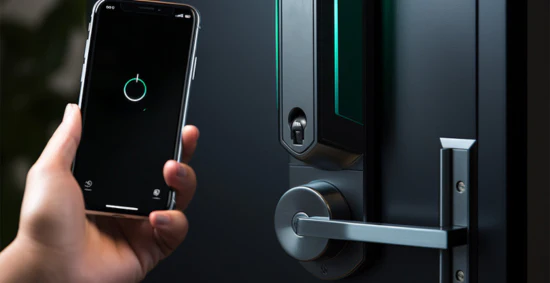If you’ve ever found yourself pondering the intricacies of smart lock functionality, you might also have wondered about a certain aspect that involves the judicious management of power resources. Smart locks, in their quest to provide you with seamless access to your abode, may have some characteristics that prompt a consideration of power consumption. Read Digital Door Lock in Hyderabad, Gurgaon & Delhi
But before you dismiss the notion outright, there are nuances to explore that could shed light on the impact of this potential drain on your device. Stay tuned to unravel the mysteries behind whether smart locks truly have an appetite for battery life.
Smart Lock Battery Drainage Factors
- To understand smart lock battery drainage factors, consider the various components that contribute to power consumption. Smart locks are innovative devices that provide convenience and security, but they also rely on battery power to function effectively. Power consumption analysis is crucial in determining how long your smart lock’s batteries will last. By understanding the factors that influence battery drainage, you can implement battery saving techniques to prolong the lifespan of your smart lock’s batteries.
- One of the primary factors affecting smart lock battery drainage is the frequency of use. The more often the smart lock is accessed, the more power it consumes. Additionally, the type of communication protocol used by the smart lock can impact power consumption. For example, Bluetooth-enabled smart locks may drain batteries faster than those using Wi-Fi due to the differences in energy efficiency. By optimizing settings and utilizing power-saving features, you can effectively manage and reduce the power consumption of your smart lock.

Tips to Extend Smart Lock Battery Life
- Considering the factors influencing smart lock battery drainage, optimizing settings and utilizing power-saving features can significantly extend the lifespan of your smart lock’s batteries. To enhance battery longevity, start by adjusting the auto-lock and auto-unlock settings to reduce unnecessary activations. By increasing the time intervals before these features engage, you can minimize the frequency of battery usage.
- Additionally, disabling any non-essential functions like LED lights or sound effects can contribute to conserving power. Another effective strategy is to enable energy-efficient modes offered by your smart lock, such as low-power Bluetooth connectivity or sleep modes during inactive periods.
- Regularly checking for firmware updates is also essential as manufacturers often release optimizations that can improve battery efficiency. Implementing these power-saving techniques won’t only prolong your smart lock’s battery life but also reduce the need for frequent replacements, saving you time and money in the long run.
Impact of Connectivity on Battery Usage
- Connectivity plays a crucial role in determining the battery usage of your smart lock. The efficiency of the connection established between your smart lock and the controlling device directly impacts the power consumption. To optimize battery life, focus on enhancing connectivity efficiency and implementing power-saving techniques.
- Ensuring that your smart lock is connected to a stable and strong Wi-Fi network can significantly reduce power consumption. Weak or unstable connections can cause the smart lock to continuously search for a signal, leading to increased battery drain. Additionally, using Bluetooth Low Energy (BLE) technology instead of traditional Bluetooth can help conserve power by maintaining a low-energy connection between devices.
- Implementing power-saving techniques within the smart lock system can further extend battery life. For instance, enabling sleep modes during periods of inactivity can reduce power usage. Moreover, adjusting settings to minimize the frequency of data exchanges between the smart lock and the controlling device can also contribute to preserving battery power. By prioritizing connectivity efficiency and utilizing power-saving techniques, you can effectively manage and optimize your smart lock’s battery usage.
Managing Smart Lock Notifications Effectively
- For efficient management of smart lock notifications, prioritize customization options to streamline alerts based on your specific needs and preferences. Utilize the notification settings on your smart lock app to tailor notifications to your liking. This allows you to receive alerts for critical events while reducing unnecessary notifications that may drain your device’s battery.
- To optimize battery usage, consider adjusting the frequency and type of notifications you receive. Choose to receive alerts only for essential events such as door unlocks or failed access attempts. By minimizing the number of notifications, you can help prolong your device’s battery life.
- Additionally, explore the option to group notifications or enable a summary feature if available. This can consolidate multiple alerts into a single notification, reducing the overall number of notifications your device has to process and display.
Best Practices for Smart Lock Battery Optimization
- To optimize the battery life of your smart lock, adjust notification settings to receive only essential alerts such as door unlocks or failed access attempts. Smart lock battery preservation is crucial for ensuring uninterrupted security features. Implement energy-saving techniques by disabling unnecessary features like constant LED indicators or sound notifications. These small adjustments can significantly extend the battery life of your smart lock.
- Another way to optimize smart lock battery usage is by using low-energy Bluetooth connections whenever possible. Keeping your smart lock updated with the latest firmware can also help in improving energy efficiency. Additionally, consider using high-quality batteries or rechargeable batteries to ensure consistent power delivery.
- Regularly check the battery levels of your smart lock through the associated app and replace them promptly when low. Avoid using standard alkaline batteries as they drain faster than lithium batteries. By following these smart lock battery optimization practices, you can enjoy a longer-lasting and more reliable security system for your home.
Conclusion
In conclusion, smart locks can drain battery due to various factors such as connectivity issues, excessive notifications, and environmental conditions. To extend battery life, follow tips like using high-quality batteries, adjusting settings, and keeping the lock updated. By optimizing battery usage and managing notifications effectively, you can ensure your smart lock remains secure and reliable for an extended period of time.







Leave a Reply